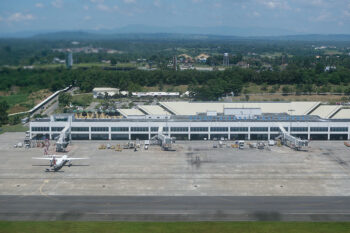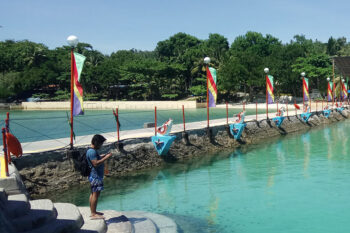[Eidu l-adha khutbah delivered at Balay Kalinaw, University of the Philippines Diliman on 14 October 2013.]
QUEZON CITY (MindaNews / 16 Oct) – Today, Makkah including Mina and Arafah is bustling with more than two million people all raising their voices with their takbir: “Labbayk allahumma labbayk laa sharika laka labbayk inna l-hamda wa n-ni’mata laka wa l-mulk laa sharika lak.” [Here we come, O Allah, here we come. Here we come. You don’t have partner. Here we come. Praise, indeed, and blessings, are Yours, Your Grace and Kingdom! You have no partner.]
These are loud utterance and prayer of pilgrims during their sacred journey in the Holy City. These are the same utterance of Prophet Muhammad (SAW) and his companions during their time, and the same utterance and prayer of Prophet Abrahim (AS) and his family and descendants during their time.
Fortunate are those who have gone to Makkah for hajj and have witnessed and experienced the same hajj rituals and who have done the same utterance and declaration during their journey. Like the countless multitude of humanity who had done the same journey before and the multitude that will do the same process in the future, the people in hajj today are indeed very blessed. As we share the same spirit of hajj, we resonate the same enthusiasm with our eidu l-adha (Feast of sacrifice) today.
Primal replica
The hajj and tawaf or circumambulation of pilgrims around the Ka’abah is a replica of primal act of nature – the rotational movement of any entity in creation around a center like atomic particles rotating around a nucleus or planets around the sun. This description has never been vividly displayed in today’s social media, showing that the fifth pillar of Islam – the hajj – is not just an ordinary ritual with no essential significance; rather, it reflects the process of worship of all entities in creation as shown in their perpetual movement. Many Facebook users must have watched the similarity of hajj rituals and the movements of the universe at their most vivid display.
The hajj, no doubt, is the most enduring tradition of prophets that continues to resonate until our time. By prophet we are not only referring to Prophet Muhammad (SAW). We refer practically to all prophets particularly Prophet Ibrahim (AS) and his descendants who most of them were prophets too. As the Qur’an puts it, the physical and sacral importance of the hajj is intrinsically related to righteousness and right conduct, taqwa (piety) and wisdom. The Qur’an reads:
“For hajj are the months well known. If anyone undertakes that duty therein, let there be no obscenity, no wickedness, no wrangling in the hajj. And whatever good ye do (be sure) God knoweth it. And take a provision (with you) for the journey, but the best of provisions is right conduct, so fear Me O ye that are wise (Baqarah: 197).”
Moreover, the hajj is linked to man’s original nature and the instrumentality in bringing out such nature by effacing his or her sin as circumstances of his or her action and day-to-day living. Prophet Muhammad (SAW) said:
“A person who performs the pilgrimage during which neither indulges in lewdness nor abuses, such a person returns (from the pilgrimage duly purified) as if born by his mother on that very day (Riyadu s-shaaleheen, Vol. II, p. 615).”
Prophetic and post-prophetic history
The universal and natural trait, ethical foundation and purifying effects of hajj as instrument in recovering the primal nature of man as if he or she has just been borne again when or after performing hajj would probably explain the primordial and continuing relevance of the hajj that cuts across prophetic and post-prophetic history – a reason why hajj remains the most enduring congregation of countless mass of people in single, unchanged, holy place every year.
The difference between the two lines of history is obviously the clear dialectical forces during prophetic era usually with immediate resolution of historical antagonism in favor of the prophets. Whereas in our time and since the death of Prophet Muhammad (SAW), the clash of haq (truth) and batil (falsehood) hardly reflects in simple dialectical term of history or clearly resolved with finality. The flow of Islamic history since the caliphate period, the contestation therein including the rivalry of dynasties and petty-dynasties, sultanates and kingdoms until the birth of Muslim nation-states reflect multi-faceted lines of history revealing, as it were, both clash and convergence within the Muslim world, and externally, with the rest of international community.
Our time thus or what we refer to as post-prophetic history must reveal dynamic perspective of hajj. Indeed, each period of history must have revealed such perspective reflecting the hajj’s universal message. What is unique in our time is the immense complexity into which the Muslim world has been thrust into nowhere seemingly orphaned in the world of nation-states with international law dominated by big powers using brute force characterized by what Hedley Bull as “anarchical society” and with the Muslim world hardly able to find its voice in such society.
Afghanistan, Iraq, and Syria
Cases in point are the US invasion of Afghanistan and Iraq few years ago, and recently, the almost catastrophic US military strike of Syria; if not temporarily averted three weeks ago, it could have triggered a nuclear holocaust in the Middle East given the proxy war the war in Syria has become with big powers, Israel, Iran and Saudi Arabia and other Gulf States playing varying roles and divergent interests. While the present war in Syria remains uncertain and critical, the Arab spring happening in many countries in the Middle East and North Africa remains equally volatile with no clear future in sight.
There is relatively similar vociferations when we go farther into other parts of the Muslim world like many Muslim minorities as shown with worsening plights of the Palestinians, the Kashmiris, the Rohingyan Muslims, the Patanis, the Bangsamoro and so on. They remain dominated and hardly able to breathe a sigh of relief in their own homelands.
Ironically, Muslim countries that have benefited from the arrangement of nation-states are as heartless on the plight of minorities. While they have been fortuitous of having gained their independence with less politics and struggle as some of them simply received their independence in silver platters from their colonial masters, they are as jealous of their sovereignty while they could easily brandish their “national security” like trump cards against minorities.
Incidentally, the common denominators of both majority and minority members of the Muslim ummah is that, they are all descendants of Prophet Abrahim (AS) professing and following the hajj tradition. In other words, they all partake the Abrahamic mantle, just as the claim of the Yahud’s and the Nasaara’s as the latter invoked their genealogical affinity on other side of Abrahamic line – that of Prophet Ishaq (AS) and Ya’qub (AS).
What is clear however, since the collapse of the Ottoman Empire in the 19th century, the plight of the ummah had never been generally resolved according to their terms. Moreover, since the Sykes-Picot Agreement in 1915 old maps of the Arab world had been drawn with what we know today. With the present war in Syria, many strategic analysts believe, a new Sykes-Picot blueprint is at work to re-draw the map of the Middle East possibly with Syria divided into north and south and with new Arab state in the offing. While this is going on, the age-long Palestinian struggle like others is left wallowing in uncertainty with the Arab world hardly able to take bold step to regain their pride and respectability since 1973.
Examining history
Examining the malaise of the Muslim world and how her history remains open-ended and dialectically inconclusive, it is not far-fetched to see the Muslim ummah like orphans under staring eyes and big sticks brandished against them by big brothers as they have no one to turn to and help resolve their plight and their problems, certainly not the United Nation, let alone, the Organization of Islamic Cooperation, the Arab League, and so on.
Yet, a clear reading of the Holy Qur’an reveals that despite the malaise of the ummah, the promise of the Allah (SAW) to Prophet Ibrahim (AS) as a model and as harbinger of “Good in this world” (fi d-dunya hasanah) and with the ummah as Abraham’s descendants partaking that promise make the whole historical negativism and political pessimism of the ummah unfounded.
The Qur’an reads:
Abraham was indeed a model, devoutly obedient to Allah, (and) true in faith, and he joined not gods with Allah.
He showed his gratitude for the favors of Allah, who chose him, and guided him to a Straight Way.
And We gave him Good in this world, and he will be, in the Hereafter, in the ranks of the Righteous.
So We have taught thee the inspired (message), “Follow the ways of Abraham The True in Faith, and he joined not gods with Allah (An-Nahl:120-123).”
With the foregoing, it is clear that narrow prism in understanding politics and history of the Muslim world falls apart when we relate the promise of Allah (SWT) to Prophet Ibrahim (AS) and his descendants given the Sirat or Way assured on them – a reason why Prophet Ibrahim’s tradition like the hajj remains as enduring and vibrant until our time.
Hidayah as prism of understanding
There is thus a need to fine-tune our prism. Certainly, conventional prism of politics and history is not able to provide us holistic and inspiring perspective about the Muslim world.
Indeed, the hidayah or guidance of Allah (SWT) is something that is immeasurable and unpredictable. It happens in its own way, in its own time, in its own place. Thus, we have to provide some adjustment or space into our understanding of our history and in our condition by reflecting the idea of hidayah bestowed not only during the time of Prophet Ibrahim (AS) and Nabi Muhammad (SAW) and his companions including our time as well.
As the Muslim world in particular witnessed varying episodes of tragedy and problem, fact is, the ummah has continued to withstand various challenges. The hajj is a testament how the ummah progressed and developed continuously. In fact, it is not only attracting those in the traditional home of dar al-Islam (Land of Islam). Ironically, the new source of inspiration has now practically bestowed or has been enveloped those previously non-Islamic communities in the West; to the extent that the number of hajj continues to increase year after year, even as the Saudi government has to regulate the number due to difficulty in extending provision and accommodation or providing security to multitude of pilgrims. Those coming from China, coming from Europe and coming from the United States and elsewhere are just as inspired with their performance of hajj.
It is because there is mystery or power in the hajj that continues to attract people across geographical divides as hidayah dawns upon them. There are no variations from places they come from; when hidayah comes, they cannot but will have to respond and heed the call like others and journey to the Holy City of Makkah. The Qur’an says:
“And proclaim the Pilgrimage among men: they will come to thee on foot and (mounted) on every kind of camel, lean on account of journeys through deep and distant mountain highways (Hajj: 27).”
This explains why the number of hajj has increased every year where people of various nationalities come from different countries, continents, and regions. All this shows that we don’t need to sour-grape with our politics, our history, and our condition. The mystery of hidayah or guidance of Allah (SWT) works in many ways.
The Qur’an says: “verily, real guidance is from Allah.” And in another verse, the Qur’an says: “they plan and Allah plans and Allah is the best of planners.”
This impresses that we need to, at least, appreciate that space in understanding our history – a space that is enveloped by something mysterious by something that we cannot predict or we cannot identify except the wisdom inherent in the idea of hidayah. This is the power bestowed on people who flock to hajj. Finally, we remind you including myself of this simple idea of the life of Prophet Ibrahim (AS), the hajj, the malaise of our time, and hidayah which, viewed creatively or dynamically, will provide us wisdom and understanding.
[MindaViews is opinion section of MindaNews. Julkipli Wadi is Associate of Islamic Studies at the University of the Philippines Diliman].







